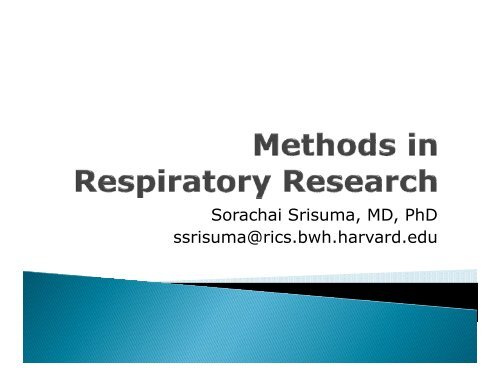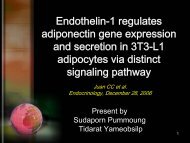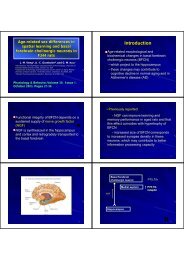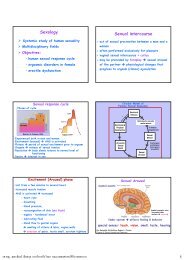Sorachai Srisuma MD PhD Sorachai Srisuma MD PhD ssrisuma@rics.bwh.harvard.edu
Sorachai Srisuma MD PhD Sorachai Srisuma, MD, PhD ssrisuma ...
Sorachai Srisuma MD PhD Sorachai Srisuma, MD, PhD ssrisuma ...
- No tags were found...
Create successful ePaper yourself
Turn your PDF publications into a flip-book with our unique Google optimized e-Paper software.
<strong>Sorachai</strong> <strong>Srisuma</strong> <strong>MD</strong> <strong>PhD</strong><br />
<strong>Sorachai</strong> <strong>Srisuma</strong>, <strong>MD</strong>, <strong>PhD</strong><br />
<strong>ssrisuma@rics</strong>.<strong>bwh</strong>.<strong>harvard</strong>.<strong>edu</strong>
Both are performed under flexible<br />
bronchoscopy.<br />
Histological analyses of airway tissue provide<br />
◦ The information of pathological changes.<br />
◦ Assess potential therapeutic effects in pharmacological<br />
studies.<br />
EBB allow the assessment of large airway, but<br />
not the entire thickness.<br />
TBB allow the assessment of the distal lung<br />
including the distal airway wall and the alveolar<br />
tissues.<br />
Limitations of TBB are major complications<br />
such as bleeding and pneumothorax.
Epithelial Basement Subepithelial<br />
alteration membrane fibrosis<br />
thickness<br />
Asthma Detachment +++ +++<br />
COPD metaplasia + ++<br />
+ represents the degree of association with disease
Mucus gland Smooth Angiogenesis<br />
hyperplasia muscle<br />
mass<br />
Asthma ++ +++ +++<br />
COPD +++ ++ +<br />
+ represents the degree of association with disease
Resected tissue needs to be preserved<br />
◦ Frozen<br />
◦ Embedded in paraffin<br />
Electron microscopy<br />
Histochemical staining<br />
Immunohistochemistry<br />
In situ hybridization
H&E (Haematoxylin and eosin) staining<br />
Total collagen stain<br />
◦ Sirius red<br />
◦ Van Gieson<br />
◦ Masson-trichrome<br />
PAS (periodic-acid shiff) staining is used to<br />
visualize the mucus glands or mucuscontaining<br />
cells.<br />
Elastin staining<br />
Hypoxia staining (pimonidazole<br />
hydrochloride)
Bronchiole –H&E staining
PAS staining in mouse lung
Hypoxia of airway epithelial cells<br />
Bronchiole –H&E staining<br />
β-ENaC overexpressing<br />
mice<br />
wild type mice
It allows detection of specific proteins using<br />
specific antibody.<br />
The signal detected by IHC reflects the<br />
tissue expression of proteins.
SERPINE2 (PN1) localization<br />
in mouse lungs
Immunofluorescence
It allows detection of specific mRNA using<br />
specific probes (oligonucleotides).<br />
The signal detected by ISH reflects the<br />
tissue and cellular l expression of mRNA.
Bronchoalveolar lavage (BAL)<br />
Induced sputum<br />
Exhaled breath condensate<br />
Blood<br />
Urine
Is performed under flexible bronchoscopy at<br />
the same time as EBB.<br />
Is routinely used to study cellular composition<br />
and to measure the levels of<br />
cytokines/chemokines in the distal airway and<br />
alveoli.<br />
Cannot differentiate the individual components<br />
of the distal airway and alveolar compartments.<br />
The cellular component mainly represents the<br />
luminal inflammatory cells and some bronchial<br />
epithelial cells.
Stained BAL cells
Stained BAL cells
Hypertonic saline-induced sputum<br />
Is used to evaluate airway inflammation in<br />
the central airway.<br />
Can be used to study cellular components<br />
from the mucus.<br />
Soluble remodeling-associated proteins,<br />
such as procollagen synthesis peptides,<br />
MMP, TIMP and cytokines, can be detected<br />
in the sputum supernatants.
Is a noninvasive method and reflects the<br />
composition of the fluid lining the airway.<br />
Several markers including hydrogen<br />
peroxide, leukotrienes, prostaglandins,<br />
isoprostanes, nitro oxide-derived products<br />
and hydrogen ions have been measured<br />
successfully in EBC.
Exhaled breath condensate<br />
collecting system<br />
stem
Indirect monitoring of lung inflammation<br />
Paolo Montuschi<br />
Nature Reviews Drug Discovery 1, 238-242 (March 2002)<br />
a | Exhaled-breath condensate (EBC) collecting system, which consists of a<br />
glass condensing chamber that contains a double wall of glass for which the<br />
inner side of the glass is cooled by ice. EBC is collected between the two<br />
glass surfaces and drops to the bottom of the outer glass container in a<br />
liquid form. b | Schematic representation of a commercially available<br />
condenser. Frozen EBC is collected in the collecting vial, as indicated by the<br />
arrow.
Biomarkers of airway<br />
inflammation
Protein quantification in fluids using specific<br />
antibodies.<br />
◦ Enzyme linked-immunosorbent assay (ELISA)<br />
◦ Radio-immunoassayimmunoassay<br />
◦ Western blot analysis<br />
◦ Zymography
Primary cell isolation can be successfully<br />
performed from human tissues.<br />
◦ Epithelial cells<br />
◦ Fibroblasts<br />
◦ Smooth muscle cells<br />
◦ Endothelial cells<br />
To study the proliferative, contractile,<br />
secretory, fibrogenic properties of cells<br />
following a wide range of stimuli.
FEV 1 , FEC, FEV 1 /FVC<br />
◦ Post-bronchodilator<br />
◦ Challenge by bronchoconstrictor (Histamine,<br />
cholinergic agonists)<br />
◦ Related with airway basement membrane<br />
thickness<br />
Flow-volume loop analysis
Pathogenesis of asthma
Airway Hyperreactivity or<br />
Airway hyperresponsiveness
Gas dilution (helium)
Plethysmograph is derived from the Greek<br />
plethusmos (enlargement).<br />
It is related closely to plethus (fullness) and<br />
plethora (fullness).<br />
It is used to determine<br />
◦ Thoracic gas volume (TGV)<br />
◦ Thoracic gas volume (TGV)<br />
◦ Airway resistance (Raw)
The patient sits inside an airtight box of<br />
known volume (Vbox).<br />
inhales or exhales through a mouthpiece<br />
connected to a shutter.<br />
The pressure is monitored in 2 places<br />
◦ Pressure in the box (Pbox)<br />
◦ Pressure at the subject’s airway (Paw)
The subject makes respiratory efforts against<br />
the closed shutter (pant), causing their chest<br />
volume to expand and decompressing the air<br />
in their lungs (∆Vlung).<br />
The lung volume expanded (∆Vlung) must be<br />
equal to the gas volume compressed in the<br />
box, (∆Vbox)) at constant t temperature.<br />
t<br />
At the end of respiration, there is no flow, Paw<br />
corresponds to alveolar pressure.
Flow signal<br />
is negative<br />
during inspiration<br />
Box pressure signal<br />
is positive<br />
during inspiration
Flow signal<br />
is positive<br />
during expiration<br />
Box pressure signal<br />
is negative<br />
during inspiration
The mouth shutter is closed.<br />
Record mouth pressure vs box pressure for<br />
determining TGV.<br />
Mouth pressure<br />
(cmH 2 0)<br />
Box pressure (cmH 2 0)
At constant temperature,<br />
P1V1 = P2V2<br />
◦ P1 and V1 are initial pressure and volume.<br />
◦ P2 and V2 are final pressure and volume.<br />
PboxVbox = (Pbox+ ∆ Pbox) (Vbox- ∆ Vbox)<br />
∆ Vbox can be calculated<br />
In this case, ∆ Vbox equals ∆ Vlung<br />
∆ Vlung can be measured directly by<br />
connecting the mouthpiece to a spirometer,<br />
instead of calculating it as ∆ Vbox.
P1V1 = P2V2<br />
◦ P1 and V1 are initial pressure and volume.<br />
◦ P2 and V2 are final pressure and volume.<br />
Paw x FRC = (Paw-∆Paw) (FRC +∆ V Vlung) )<br />
FRC can be calculated
Body plethysmography is particularly<br />
appropriate for patients who have air spaces<br />
within the lung that do not communicate<br />
with the bronchial tree.<br />
In these individuals, gas dilution methods of<br />
measurement would give an erroneously low<br />
volume reading.
The subject is asked to begin shallow<br />
breathing at faster rate (1 breath per<br />
second) and flow vs box pressure is<br />
recorded.<br />
d<br />
Flow<br />
(Liter/sec)<br />
Box pressure (cmH 2 0)
When normal human expires fully to residual<br />
volume, airways in the dependent lung regions tend<br />
to close because of the high intrapleural pressure<br />
there, when airways to upper lobes are still open.<br />
The first gas entering the lungs on next inspiration<br />
will go preferentially to upper lobes.<br />
If the first gas inspired is a foreign gas, upper lobes<br />
will have a much higher concentration of it than<br />
lower lobes.<br />
On the succeeding expiration, the lung volume at<br />
which airways in lower lobes begin to close will be<br />
marked by a sudden rise in concentration of the<br />
foreign gas in expired air, since it is no longer<br />
diluted by gas from lower lobes.
Ask the patient to breath out to residual volume.<br />
Allow the patient to maximally breath in<br />
100%O 2 to TLC.<br />
Arrange the next inspiration so that the patient<br />
first draws into his alveoli his dead space gas.<br />
This dead space air (high N 2 concentration) goes<br />
mainly to upper lobes.<br />
O 2 then goes preferentially to lower lobes and<br />
decreases the N2 concentration there.<br />
N 2 concentration in the expired air can then be<br />
measured continuously.
Single breath N 2 washout test<br />
p.507-8, สรรวทยาเลม สรีรวิทยาเล่ม 2
An increase in the slope of the increase in<br />
nitrogen percentage during the plateau<br />
(alveolar-emptying) stage indicates<br />
unevenness of alveolar l ventilation, and thus<br />
abnormal VA/Q ratios.<br />
Well-ventilated alveoli empty first.<br />
Poorly-ventilated alveoli empty last.<br />
Poorly-ventilated alveoli with high O 2 at base<br />
of the lungs tends to lower the initial<br />
plateau-nitrogen concentration.
When, as a result of dynamic compression, mid-size<br />
airways in the base of the lungs collapse during the<br />
"single breath nitrogen washout test," the<br />
percentage of nitrogen in mixed exhaled air<br />
markedly increases.<br />
This is because once the basal airways close, only<br />
the apical airways remain open and continue to<br />
empty.<br />
Because of their low compliance, the apical alveoli<br />
receive less of the inhaled oxygen, thus when they<br />
alone are emptying, the percentage of nitrogen in<br />
the mixed exhaled air markedly increases.
The volume at which this occurs is called the closing<br />
volume.<br />
Closing volume is increased in obstructive lung<br />
disease. It also increases with age and by 65 years-<br />
of-age is nearly equal to the FRC. The increased<br />
closing volume is a sign of "loss of interdependence"<br />
due to loss of lung tissue.








![Integ50 MedII_KSA3 [Compatibility Mode].pdf](https://img.yumpu.com/53541610/1/190x146/integ50-medii-ksa3-compatibility-modepdf.jpg?quality=85)

